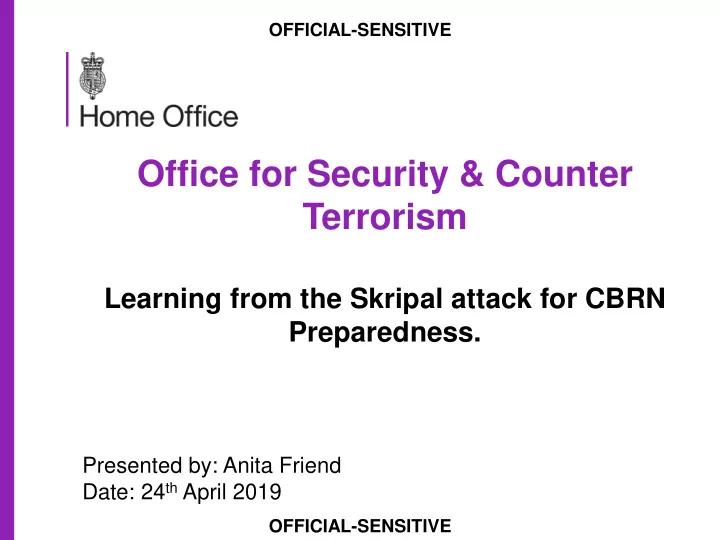

OFFICIAL-SENSITIVE Office for Security & Counter Terrorism Learning from the Skripal attack for CBRN Preparedness. Presented by: Anita Friend Date: 24 th April 2019 OFFICIAL-SENSITIVE
Reflections – Skripal response The response was effective and impressive but at times very difficult • The ‘FUSION’ of health, science, policy and communications was essential to make risk based decisions against an incomplete evidence picture. • The event presented challenges not reflected in our planning process and generated large impacts locally, nationally and internationally. • Departments were unable to share information, due to a lack of awareness of the system, and who needed to know. • The event spanned Resilience / National Security / Defence 2
The Challenge of the Skripal Event Political Dimension Salisbury International CBRN Dimension Response 3
Root Causes A CBRN attack is different to a conventional attack • Inherent uncertainty of what has happened • Therefore a greater reliance on science, public health and SME’s to understand what has happened. • Greater need for coordination and collaboration due to multiple critical interdependencies. • CBRN is a multi dimensional risk with different factors that can potentially change the response required. 4
Deductions • There is a disconnect between those who are responsible for the spectrum of CBRN risks, and those that deliver the capability for those risks. • The national planning assumptions for CBRN risks do not represent the full range of challenges. • There is no one organisation/department that has a full system awareness of the CBRN risk • Capabilities are generated without the visibility of the risk owners. • Capabilities whilst effective in isolation, may not deliver against the risk spectrum. In the light of the shift in threat, the lack of whole system approach to CBRN preparedness increases our vulnerability . 5
Next Steps Intent To deliver a fusion based approach to CBRN Preparedness for the UK in order to address the systemic barriers to joint CBRN risk, planning, awareness and delivery. Phase 1 Phase 3 Phase 2 Short Term Long Term >6mths Medium Term <6mths • NSSIG CT agrees with the • Deliver CSR bid proposal • Cross government team to produce: • Deliver CBRN response findings and deductions • Cross government CBRN ownership and • NSSIG CT agrees to own strategy delivery map – Understand the System • Manage a cross government domestic CBRN (regardless • Factors that shape a CBRN Response to: of actor/motive) work program to close • Better inform planning • Stakeholder Departments capability gaps. assumptions • Jointly feed into NRA/NRPA (TBC) agree to form and • Understand capability gaps resource a cross process to ensure they reflect Derived from Policy and Scientific government team to the multidimensional factors inputs (CSAs) address CBRN that shape a CBRN response. • Develop a cross government CBRN • Maintain a fusion based Preparedness response strategy • Min 1 FTE per core approach to CBRN • Develop and ratify a comprehensive department (MOD, preparedness, either virtually CBRN preparedness governance CO, DHSC, DEFRA, or physically. structure HO OSCT) • Joint CSR bid to • Min 1 PoC per • Enshrine Fusion based approach supporting to CBRN preparedness department (DfT, • Close capability gaps identified. BEIS, UKIC, CT Police, HO CPFG) Official Sensitive 6
Questions 7
Recommend
More recommend